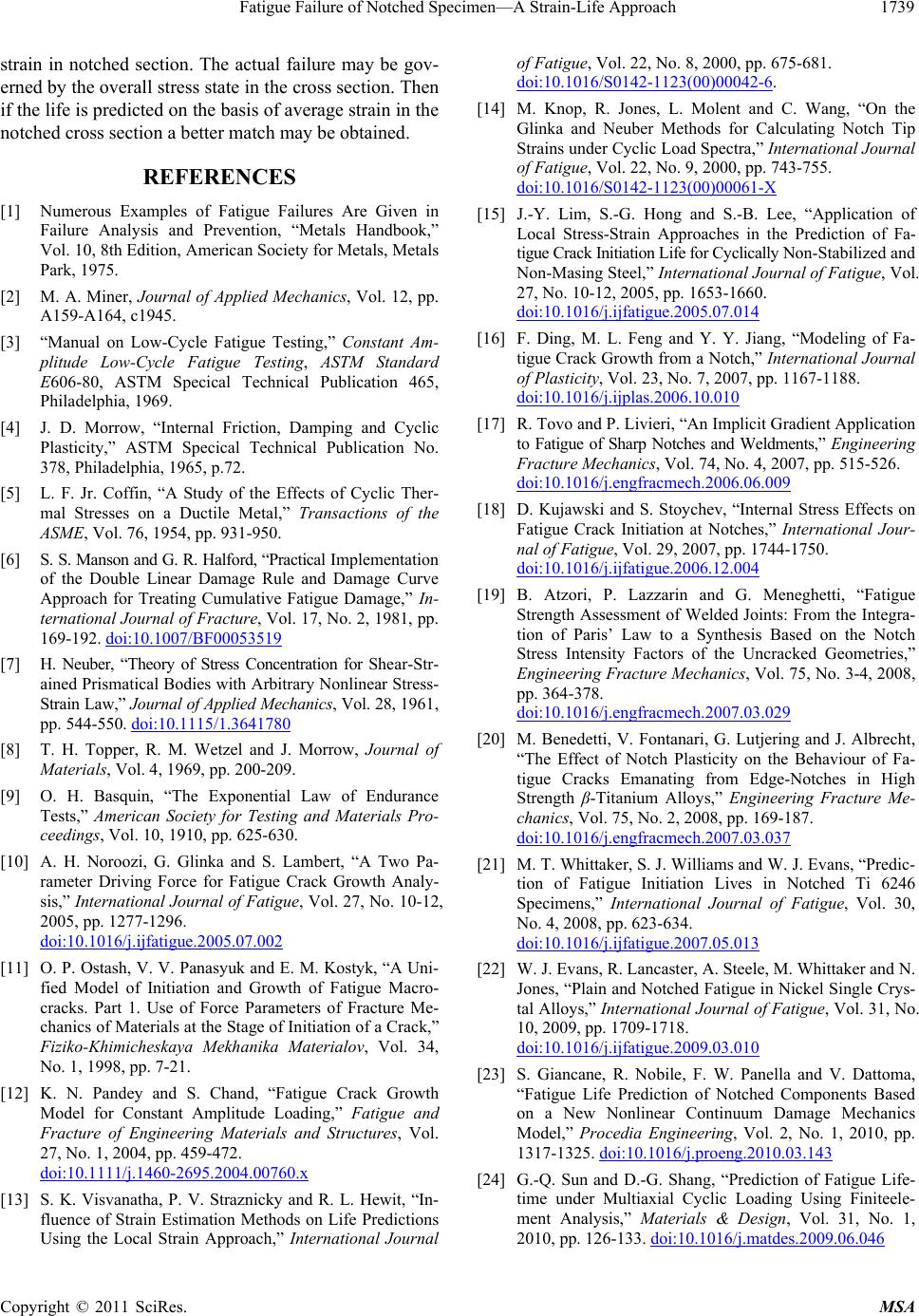
Fatigue Failure of Notched Specimen—A Strain-Life Approach1739
strain in notched section. The actual failure may be gov-
erned by the overall stress state in the cross section. Then
if the life is predicted on the basis of average strain in the
notched cross section a better match may be obtained.
REFERENCES
[1] Numerous Examples of Fatigue Failures Are Given in
Failure Analysis and Prevention, “Metals Handbook,”
Vol. 10, 8th Edition, American Society for Metals, Metals
Park, 1975.
[2] M. A. Miner, Journal of Applied Mechanics, Vol. 12, pp.
A159-A164, c1945.
[3] “Manual on Low-Cycle Fatigue Testing,” Constant Am-
plitude Low-Cycle Fatigue Testing, ASTM Standard
E606-80, ASTM Specical Technical Publication 465,
Philadelphia, 1969.
[4] J. D. Morrow, “Internal Friction, Damping and Cyclic
Plasticity,” ASTM Specical Technical Publication No.
378, Philadelphia, 1965, p.72.
[5] L. F. Jr. Coffin, “A Study of the Effects of Cyclic Ther-
mal Stresses on a Ductile Metal,” Transactions of the
ASME, Vol. 76, 1954, pp. 931-950.
[6] S. S. Manson and G. R. Halford, “Practical Implementation
of the Double Linear Damage Rule and Damage Curve
Approach for Treating Cumulative Fatigue Damage,” In-
ternational Journal of Fracture, Vol. 17, No. 2, 1981, pp.
169-192. doi:10.1007/BF00053519
[7] H. Neuber, “Theory of Stress Concentration for Shear-Str-
ained Prismatical Bodies with Arbitrary Nonlinear Stress-
Strain Law,” Journal of Applied Mechanics, Vol. 28, 1961,
pp. 544-550. doi:10.1115/1.3641780
[8] T. H. Topper, R. M. Wetzel and J. Morrow, Journal of
Materials, Vol. 4, 1969, pp. 200-209.
[9] O. H. Basquin, “The Exponential Law of Endurance
Tests,” American Society for Testing and Materials Pro-
ceedings, Vol. 10, 1910, pp. 625-630.
[10] A. H. Noroozi, G. Glinka and S. Lambert, “A Two Pa-
rameter Driving Force for Fatigue Crack Growth Analy-
sis,” International Journal of Fatigue, Vol. 27, No. 10-12,
2005, pp. 1277-1296.
doi:10.1016/j.ijfatigue.2005.07.002
[11] O. P. Ostash, V. V. Panasyuk and E. M. Kostyk, “A Uni-
fied Model of Initiation and Growth of Fatigue Macro-
cracks. Part 1. Use of Force Parameters of Fracture Me-
chanics of Materials at the Stage of Initiation of a Crack,”
Fiziko-Khimicheskaya Mekhanika Materialov, Vol. 34,
No. 1, 1998, pp. 7-21.
[12] K. N. Pandey and S. Chand, “Fatigue Crack Growth
Model for Constant Amplitude Loading,” Fatigue and
Fracture of Engineering Materials and Structures, Vol.
27, No. 1, 2004, pp. 459-472.
doi:10.1111/j.1460-2695.2004.00760.x
[13] S. K. Visvanatha, P. V. Straznicky and R. L. Hewit, “In-
fluence of Strain Estimation Methods on Life Predictions
Using the Local Strain Approach,” International Journal
of Fatigue, Vol. 22, No. 8, 2000, pp. 675-681.
doi:10.1016/S0142-1123(00)00042-6.
[14] M. Knop, R. Jones, L. Molent and C. Wang, “On the
Glinka and Neuber Methods for Calculating Notch Tip
Strains under Cyclic Load Spectra,” International Journal
of Fatigue, Vol. 22, No. 9, 2000, pp. 743-755.
doi:10.1016/S0142-1123(00)00061-X
[15] J.-Y. Lim, S.-G. Hong and S.-B. Lee, “Application of
Local Stress-Strain Approaches in the Prediction of Fa-
tigue Crack Initiation Life for Cyclically Non-Stabilized and
Non-Masing Steel,” International Journal of Fatigue, Vol.
27, No. 10-12, 2005, pp. 1653-1660.
doi:10.1016/j.ijfatigue.2005.07.014
[16] F. Ding, M. L. Feng and Y. Y. Jiang, “Modeling of Fa-
tigue Crack Growth from a Notch,” International Journal
of Plasticity, Vol. 23, No. 7, 2007, pp. 1167-1188.
doi:10.1016/j.ijplas.2006.10.010
[17] R. Tovo and P. Livieri, “An Implicit Gradient Application
to Fatigue of Sharp Notches and Weldments,” Engineering
Fracture Mechanics, Vol. 74, No. 4, 2007, pp. 515-526.
doi:10.1016/j.engfracmech.2006.06.009
[18] D. Kujawski and S. Stoychev, “Internal Stress Effects on
Fatigue Crack Initiation at Notches,” International Jour-
nal of Fatigue, Vol. 29, 2007, pp. 1744-1750.
doi:10.1016/j.ijfatigue.2006.12.004
[19] B. Atzori, P. Lazzarin and G. Meneghetti, “Fatigue
Strength Assessment of Welded Joints: From the Integra-
tion of Paris’ Law to a Synthesis Based on the Notch
Stress Intensity Factors of the Uncracked Geometries,”
Engineering Fracture Mechanics, Vol. 75, No. 3-4, 2008,
pp. 364-378.
doi:10.1016/j.engfracmech.2007.03.029
[20] M. Benedetti, V. Fontanari, G. Lutjering and J. Albrecht,
“The Effect of Notch Plasticity on the Behaviour of Fa-
tigue Cracks Emanating from Edge-Notches in High
Strength β-Titanium Alloys,” Engineering Fracture Me-
chanics, Vol. 75, No. 2, 2008, pp. 169-187.
doi:10.1016/j.engfracmech.2007.03.037
[21] M. T. Whittaker, S. J. Williams and W. J. Evans, “Predic-
tion of Fatigue Initiation Lives in Notched Ti 6246
Specimens,” International Journal of Fatigue, Vol. 30,
No. 4, 2008, pp. 623-634.
doi:10.1016/j.ijfatigue.2007.05.013
[22] W. J. Evans, R. Lancaster, A. Steele, M. Whittaker and N.
Jones, “Plain and Notched Fatigue in Nickel Single Crys-
tal Alloys,” International Journal of Fatigue, Vol. 31, No.
10, 2009, pp. 1709-1718.
doi:10.1016/j.ijfatigue.2009.03.010
[23] S. Giancane, R. Nobile, F. W. Panella and V. Dattoma,
“Fatigue Life Prediction of Notched Components Based
on a New Nonlinear Continuum Damage Mechanics
Model,” Procedia Engineering, Vol. 2, No. 1, 2010, pp.
1317-1325. doi:10.1016/j.proeng.2010.03.143
[24] G.-Q. Sun and D.-G. Shang, “Prediction of Fatigue Life-
time under Multiaxial Cyclic Loading Using Finiteele-
ment Analysis,” Materials & Design, Vol. 31, No. 1,
2010, pp. 126-133. doi:10.1016/j.matdes.2009.06.046
Copyright © 2011 SciRes. MSA